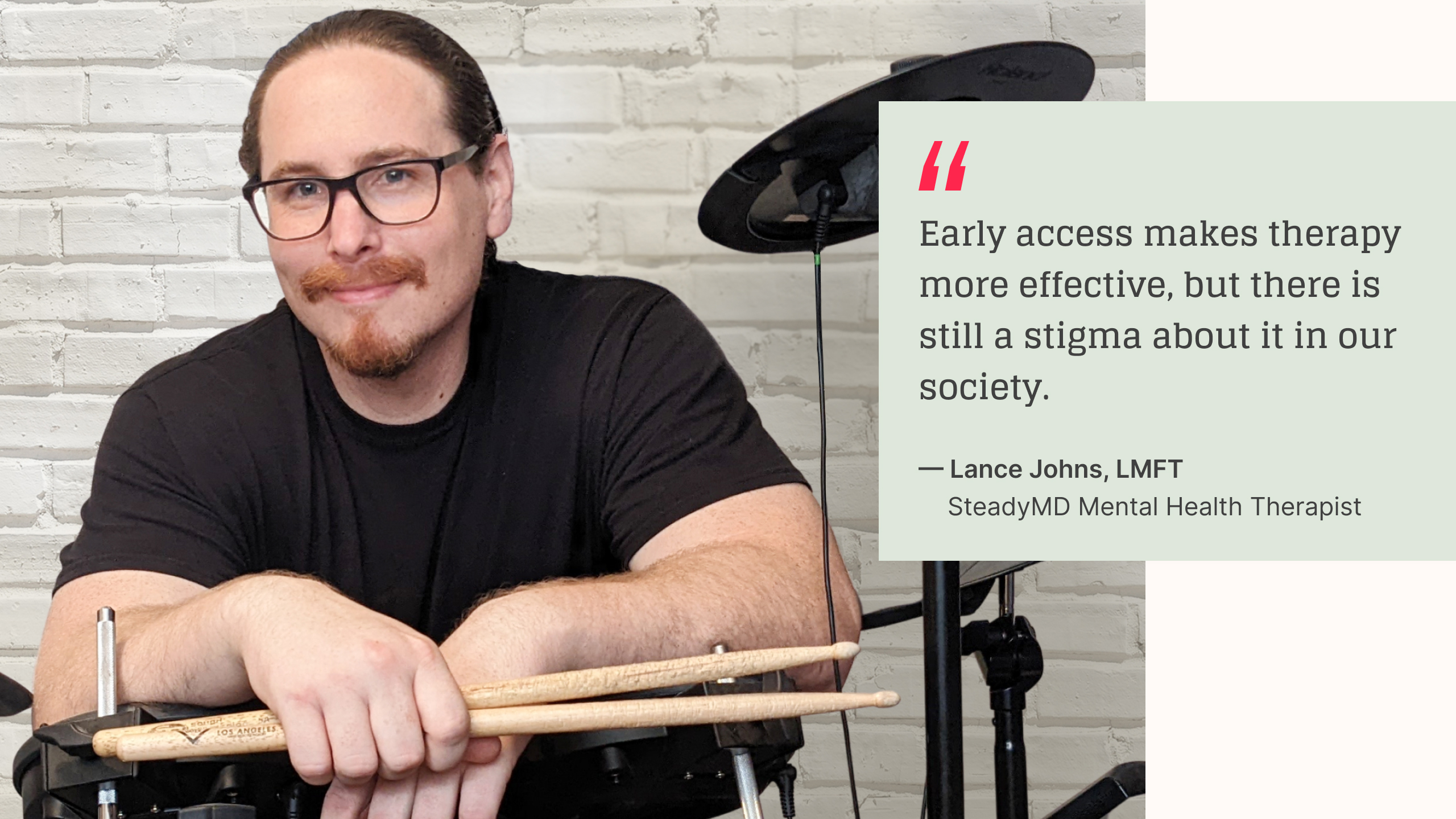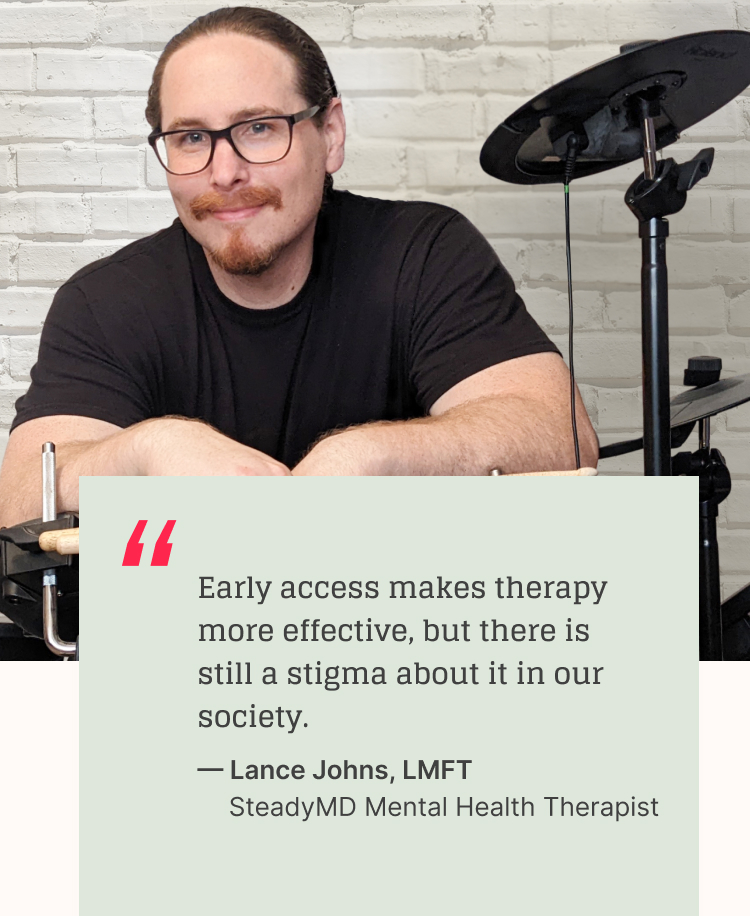Lance Johns, LMFT
Mental Health Therapist and Musician


We sat down with Lance Johns, LMFT, who has been through a lot of the same experiences as his clients. He talks about how he relates to their problems and he shares a true success story of his work.
What initially inspired you to want to become a therapist?
I grew up in a family that had a lot of addictions and I was confused about what was happening in my life. I did not do well in high school and dropped out. It was during a recession and I couldn’t get a job. So, one day, I decided to go to college because I could get a grant. I got my GED (a certificate issued for passing the General Educational Development test) and went to college.
While in college, I took my first psychology class and learned about the very things I had witnessed and experienced with my family and myself. It really resonated with me and inspired me to get into healthcare. I now have three degrees in psychology and my mom also got her GED and became a drug and alcohol counselor.
What barriers have you faced in supporting your clients, especially throughout the pandemic?
In the beginning of the pandemic, people were still adjusting to using telehealth. They would say they were used to the in-person sessions and were not sure virtual visits would work for them. However, after a few sessions, that hesitation went away and they were able to see and experience the benefits of telehealth.
With regards to the client/therapist relationship, how has working with SteadyMD helped alleviate some of those barriers?
SteadyMD has innovation and flexibility. The client doesn’t have to worry about getting up at 6 a.m. to get to a session at 8 a.m. They are less likely to miss sessions if they don’t have to worry about the commute. It’s much easier for them to join sessions in the middle of their workday. They like doing therapy in the comfort of their own home. It’s a more authentic setting and they are more free to open up to me during the sessions. It’s better for me, too, because I get to see their environment and thus am able to better connect with them. I know they feel more comfortable with me as a result. SteadyMD’s approach removes a lot of the barriers of standard therapy.
How has the client/therapist relationship been bolstered by SteadyMD?
At SteadyMD, we are using evidence-based practices across partner programs and we hire and train the most experienced therapists in all 50 states. For example, our therapists track clients’ symptoms of anxiety and depression with charts and graphs from their sessions. That enables us to see spikes and trends and the therapist can have a discussion with the client because it is clearly documented. It solves an ongoing issue of tracking client outcomes with therapy because the therapist often does not know if the sessions are working. Now we can say, “Six months ago, your anxiety level was severe, but now it’s more mild. So you are making progress.”
Why wasn’t this available before? Why is this unique to telehealth?
It has been used before, but it is being used a lot more now. In the past, we emailed surveys to clients and saw low completion rates. Now we leverage technology to gather this data more quickly and with higher completion rates by working with partners that are tech-forward and use client platforms that have better user experiences and thus higher usage rates. These platforms allow clients to not only communicate with their therapists and schedule appointments, but also to complete assessments and track their progress.
What are some improvements that have been made or experience gaps that have been filled by SteadyMD?
SteadyMD has created a more collaborative environment. Clinicians missed being able to talk to each other freely. Before, they could do this between sessions with clients.
“SteadyMD offers clinician office hours, where other clinicians and clinical leaders ask questions and get to know each other. It has created camaraderie that is often missed in telehealth.”
What benefits have virtual care in general provided you in your practice and in your personal life?
Telehealth has provided a degree of flexibility that did not previously exist. We can schedule a client at times that normally wouldn’t have worked for them because of barriers like commuting, family matters, jobs, etc. Telehealth also helps share content with clients. Examples are getting them involved with word sheets, reviewing answers to questionnaires and watching videos for psychiatric educational pieces. These elements are easily integrated into the sessions we have with clients.
What is one upside of telehealth that you were actually surprised to learn after implementing it?
I did not expect clients to be comfortable with telehealth. They seem even more comfortable with telehealth than in-person sessions. They can attend the sessions from the comfort of their own home or even with their dog on their lap. This means they often open up more quickly and are more engaged in the sessions. Therapists can even ask questions about their living space and really get to know that side of them. This is one huge upside because normally the therapist would not know what the client’s house looks like. Now the therapist can even transition the session to their phone and have the client walk around their home (if they have enough privacy) to show their living environment. This is crucial when working with someone who has depression or substance use.
Can you share a moment you felt proudest to work with SteadyMD?
I was asked to conduct training for cultural awareness. This is always critical because when providing telehealth service, the clinicians are interacting with communities/cultures they have not previously encountered. It is more important than ever to be culturally sensitive in the telehealth context. I am proud that I was able to provide training for clinicians on this topic.
In your opinion, what is one key way to tackle the current mental health crisis?
“The key is having access to care earlier on; a lot of people wait too long to get help.”
We also need better training for clinicians. Training has historically focused on diagnoses and corresponding manualized treatment protocols. Instead, there is a need for individualized care, making sure we’re looking at the whole person first and picking the method of treatment second. The more the health field moves into individualized treatment and care, the better the outcome. In the long run, clinicians will find a smaller number of people returning to therapy. People tend to go to therapy for a while, they go away and then come back again. That’s not an ideal situation.
Tell us about a breakthrough you’ve seen with a client.
Recently, I have been working with a client that is struggling with depression which has led to them drinking a lot. The sessions have been filled with a lot of tears. During one session, I was working on self-compassion with her and when her session was almost over, her dog came up and licked away her tears! This was a breakthrough. Her dog helped her laugh when she was crying. I used that as an opportunity to show that it is okay to laugh during times of struggle. It was a spontaneous moment that could only happen while doing teletherapy sessions from her home.
What are your interests outside of work?
I’m a musician. I love to play the drums and the guitar. I am also trying to grow a giant pumpkin in my backyard and am watching it grow with great interest!